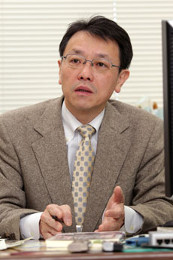

The thematic points are the following:

Dr. Yuichiro Tanioka will delliver an address titled "Recent large earthquakes and tsunamis along the Pacific coast of Central America and the tsunami early warning for those events"
Director of Institute of Seismology and Volcanology, Hokkaido University Vice-President of Seismological Society in Japan.
Dr. Yuichiro Tanioka has a PhD in Geology from the University of Michigan. He was a Researcher of the Metereological Research Institute in the Japan Metereological Agency (JMA) from 1996 to 2003. From 2003 to 2009 he was an Associate Professor in the Institute of Seismology and Volcanology at Hokkaido University. In 2009 he became Professor of that same Institute and later Director from 2010 to 2013 and again from 2016 on. Since 2016 he has been Vice-President of the Seismological Society in Japan.

Dr. Naoshi Hirata will deliver an address titled "Japanese Earthquake Researches for Seismic and Tsunami Disaster Resilience"
Director of Earthquake Prediction Research Center at the Earthquake Research Institute at the University of Tokyo, Director-General of the Research Center for Enhancing Metropolitan Resilience at the National Research Institute for Earth Science and Disaster Resilience.
Dr. Hirata has received three degrees in Geophysics from the University of Tokyo: a Bachelor of Sciences, a Master of Sciences and a Doctorate. His main áreas of interest are the observational seismology, Crustal structure, Earthquake Forescast and Seismic harzard.
During the past decade, Dr Hirata has been involved in the development and application of seismological methods for earthquake prediction research problem. He is one of the leaders of the Japanese national earthquake prediction research program to promote both basic researches and real time monitoring of the crustal process.
Dr. Hirata has led developments of the Japanese university seismic network, which utilizes the communication satellite system. He has led the joint observations in Japanese Island to understand heterogeneity in the Earth’s crust. He is a leader of the Metropolitan Project: Regional Characterization of the Crust in Metropolitan areas for Prediction of Strong Ground Motion since 2002.
His most important publications are some of the following:
Head of the National Seismological Service
Research Professor at the Institute of Geophysics of the UNAM.
She will discuss: The National Seismological Service: current situation and challenges.
Dr. Xyoli Pérez Campos graduated from the Faculty of Engineering of the UNAM, where she was part of the first class of the High Academic Performance Program and was awarded an honorable mention when she received her bachelor’s degree as a Geophysical Engineer.
Her academic performance was recognized with the Gabino Barreda medal at the preparatory and undergraduate degree levels. She completed her master's degree in Statistics and in Geophysics, as well as a doctorate in Geophysics, at Stanford University. During her doctorate, she received recognition from the Seismological Society of America for the best work submitted by a student. She also completed a post-doctorate at the California Institute of Technology (Caltech), at the end of which she joined the Engineering Faculty of the UNAM as a full-time professor in the Department of Geophysics Engineering, where she has taught since 2004.
In 2005, Dr. Pérez Campos transferred to the Geophysics Institute, also in the UNAM, where besides teaching courses at the Earth Sciences Graduate, she works as a Senior Researcher in the Seismology Department, studying the seismic structures of the subduction zone and of the Northwest of Mexico, as well as the characteristics of the source of Mexican earthquakes. She belongs to the National System of Researchers, with level 2. From 2008 to 2010, she served as the technical representative of Mexico before the Organization for the Comprehensive Nuclear Test Ban Treaty of the UN.
Dr. Xyoli Pérez Campos is currently the Vice President of the Mexican Geophysical Union and the Chief of the National Seismological Service.
Doctoral Candidate in Engineering Sciences.
Pontificia Universidad Católica de Chile
He will talk about: Ground motions for FEMA P-695 evaluation in subduction zones.
UNAM. Laboratorio de Tsunamis y Paleosismología. Instituto de Geografía.
Participa con el tema: Peligro de tsunami y fuentes de tsunami en la costa sureste de México: el gran terremoto y tsunami de Guerrero-Oaxaca de 1787 (Mw 8.6) y el terremoto y tsunami de Tehuantepec (Mw 8.2) de septiembre 2017.
Grillo.
Participa con el tema: Alertas sísmicas para comunidades remotas.
Universidad del Istmo
Participa con el tema: "Análisis fractal de actividad sísmica en México”.
Universidad del Mar, Campus Puerto Ángel
Participa con el tema: “Informe UMAR sobre Tsunamis en Oaxaca”.
Universidad del Mar, Campus Puerto Ángel
Participa con el tema: "Atlas de Riesgos de los Municipios Costeros del Estado de Oaxaca”.
Universidad del Mar, Campus Puerto Ángel
Participa con el tema: "Sismicidad en el estado de Oaxaca”.
Universidad Tecnológica de la Mixteca
Participa con el tema: "La entropía como posible premonitor ante la ocurrencia de fuertes sismos”.
University of Sierra Sur
They will give a talk on: Resilience and strategies of social participation in the population affected by the earthquakes of 2017.